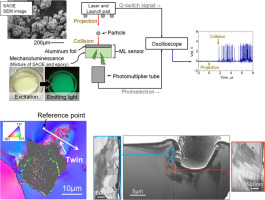Since grain refinement, such as the nano-twinning and nano-crystallization of metallic materials, can improve mechanical properties, surface modification to generate nano-structures is an in-demand technology. This study aims to conduct ultrahigh velocity impact testing using microparticle projectiles to generate indentation craters via impact. Due to the resulting extreme plastic deformation with high strain rate, grain refinement is expected to occur. This study conducts the laser-induced particle impact test (LIPIT), in which laser ablation induces supersonic ejection of a microparticle, resulting in the generation of an impact crater. We first propose a method for measuring particle projectile velocity using a mechanoluminescent (ML) material. A particle collision against the ML material emits light as a result of the mechanical stimulus. The light is detected to determine the timing of particle arrival, thus, the particle projectile velocity is obtained. This measurement method is verified using a high-speed video camera. Next, LIPIT is applied to pure copper (Cu) and pure iron (Fe), thus producing nano-structures including twinning around the impact indentation craters. To clarify this mechanism, a molecular dynamics (MD) simulation is conducted to reveal the formation of nano-twinning around the impact craters. In addition, nano-indentation testing is conducted, indicating plastic hardening around the impact craters unlike the craters obtained using quasi-static indentation. This indicates that plastic deformation due to LIPIT improves mechanical properties, owing to the extreme plastic strain and strain rates involved. Therefore, our LIPIT has potential as a new surface modification technique to induce extreme plastic deformation with ultrahigh strain rates, resulting in grain refinement.






Add Comment